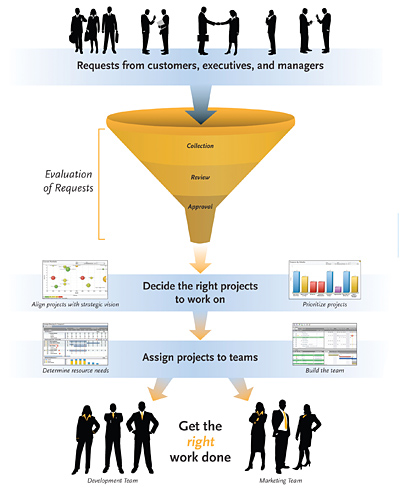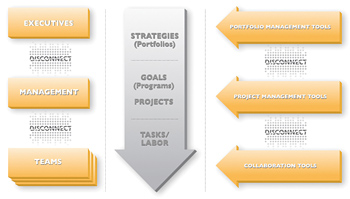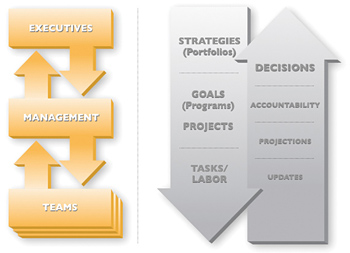The President asked, "How are you?" The janitor replied, "I'm doing great. I'm putting a man on the moon." The President left the restroom, got back on Air Force One, and flew back to Washington. There was NO problem at NASA.

Ty Kiisel
@task Inc., Orem, Utah USA
Success isn’t rocket science. President Kennedy’s visit to NASA taught us the two keys to implementing a better way to get work done:
• Align corporate strategy with workforce execution
• Engage the workforce in the project management process
As energy consumption per capita continues to increase and producers are under pressure to keep energy affordable, the need to maximize every dollar spent is a priority for every organization. The biggest challenge facing executives is making certain that initiatives undertaken at every level of the organization are focused on meeting the sometimes-competing demands of providing the electricity required, at an acceptable price.
Making Data-Driven Decisions – Doing the Right Projects, Not Just Doing Them Right
To efficiently produce electricity, business leaders need reliable and up-to-date information. When markets are down and budgets are under increased scrutiny, an organization’s need for trustworthy information becomes even more critical. However, the challenge is not in obtaining more information, but in obtaining the right information. Many organizations are surprised to discover that the solution requires a systemic approach that addresses the tactical needs of the workforce in concert with the strategic and business intelligence needs of executive decision-makers.
Knee-jerk reactions can be expensive for organizations. In fact, as many as 80% of project-based work fails to meet objectives – which means making decisions without trustworthy data can be very expensive. History has taught us that creating a formalized evaluation process, for potential and current projects, based upon alignment to corporate strategy and financial goals is the first step. Regrettably, in most organizations, it’s the squeaky wheel that gets the grease. In other words, if a powerful stakeholder has a project that he or she supports, it’s more likely to gain approval – regardless of whether or not the project provides the most business value.
Establishing a process that requires every potential project to meet pre-determined criteria for acceptance allows executives to have confidence that they are making data-driven decisions – instead of knee-jerk reactions to the demands of an influential stakeholder. Some important questions that should be asked when evaluating any project include:
• What are the high-level objectives of the project? It’s not uncommon for a project to morph into something very different from what was originally intended. Specifically identifying the goals of every project helps project teams, sponsors, and stakeholders stay on track.
• What are the estimated costs of the project – and the anticipated rewards? Without the answer to these questions, it becomes difficult to determine if the potential project will provide any business value, let alone the greatest business value.
• Does the potential project align with the mission, vision, and values of the organization? Individual projects must represent the execution of strategic direction and financial goals if the desired result is to maximize every dollar spent in the pursuit of the greatest ROI.
• What are the risks associated with pursuing the project under consideration? If potential project risks can be identified and evaluated while in the consideration process, actions can be taken to mitigate risk and increase a projects probability of success.

A formal evaluation process helps decision-makers evaluate
projects to focus the workforce on doing the right projects.
Establishing a formalized evaluation process for potential projects makes it possible for business leaders to prioritize and weight different initiatives to determine if they are worth pursuing.
Managing and Allocating Resources
Once the goals, costs, alignment, and risks, of a potential project have been addressed and defined, the project can be objectively evaluated to determine whether or not there are adequate resources available to execute the proposed project. In a perfect world, every potential initiative that provided business value would be pushed forward – however, the limits of available resources force executives to make decisions regarding the projects they will prosecute and the ones they will abandon.
Best-fit capacity planning is critical as resource pools diminish. Creating “what if” scenarios, which can be pushed around a timeline to determine which projects are feasible, allow decision-makers to objectively consider the resource implications of every project. Understanding the value of potential initiatives when measured against available resources make it possible to prioritize projects and optimize the value of an organization’s portfolio of projects.
Prioritizing and Optimizing
This is where the rubber hits the road. By weighting proposed projects, organizations can take a strategic approach to project implementation. Executives must consider their risk tolerance, the importance of return, the costs, and the potential project’s alignment to the mission, vision, and values of their organizations – and make a comparison to the answers found in the valuation.
The Hidden Secret of Successful Project- Based Work
The traditional top-down approach to work management simply doesn’t work. This is evidenced by an unacceptable failure rate of individual projects as well as a disheartening rate of failure in the Project Management Office (PMO). Some estimates actually place the PMO failure rate at 50% – about the same odds of success as flipping a coin.
To provide real business value, project-based work needs to fit within the overall business context. In other words, strategies at the executive level become the goals of the management level, and the work done in the field or on the plant floor. However, many organizations struggle with communication between the executive level, management levels, and the workforce – creating a lack of visibility, lack of foresight, and inefficiencies within the organization.

Communication disconnects between decision-makers and
the workforce create a lack of visibility, a lack of foresight
and inefficiencies within the organization.
Organizations working in silos that attempt to address their work management needs without addressing the disconnected communication issues are doomed to fail. To ensure that organizations are able to enjoy visibility, accurate business intelligence, efficiency, and the optimal use of resources, they need to employ a topdown and bottom-up management approach.
Organizations Need to Change the Way they Manage Project-Based Work
Top-down project management focuses on resource utilization, but fails to gather ground-up intelligence. The secret to successfully implementing a better work management methodology requires that organizations engage the workforce – allowing information to seamlessly flow up to executives and across departments.

The secret to successful work management requires that
organizations engage the workforce – allowing information
to seamlessly flow up to executives and across departments.
Any methodology that fails to engage the workforce handicaps its ability to collect accurate and timely information for decision-making. Executive dashboards and project reports are of no value if the information isn’t trustworthy or is out of date. The secret to successful work management resides in an engaged workforce. User involvement enables good decision-making. Implementing a top-down and bottom-up methodology gives organizations visibility, accountability, and operational effectiveness.
NV Energy’s Vendor-Managed Inventory Project – A Systemic Work Management Approach
NV Energy has supplied the power needs of northern Nevada and northeastern California for more than 150 years, and Southern Nevada since 1906. With the help of BDM Consulting, a global supply chain management consultant, the company strategically transferred thousands of internal inventory items used for maintenance, repair, and operations on plant systems, from a company- owned inventory to a consigned vendor-managed inventory (VMI) model.
Because NV Energy’s power generation system spans a service area of 54,500 square miles, the initiative required a work management solution and methodology that accommodated a geographically diverse and departmentally dispersed workforce. To successfully implement new business processes, the new work management methodology needed to:
• Provide transparency into the VMI initiative so BDM, NV Energy, the individual power plants, and the selected vendor had complete visibility and accountability into the new inventory management process and its implementation.
• Enable BDM to efficiently manage the new inventory management implementation processes vertically with NV Energy’s selected supplier and horizontally across the plant fleet and supporting departments.
• Facilitate collaboration among NV Energy management and power generation locations hundreds of miles from each other.
• Quantify the cost savings of the VMI initiatives and manage issues throughout the project.
A Successful Implementation
Taking a top-down and bottom-up approach to managing the process enabled NV Energy to obtain:
Immediate visibility and accountability – Engaging the workforce in the process allows NV Energy to capture real-time business intelligence. Every time someone on the plant floor or their inventory vendor updates task status, executive reports and dashboards are instantaneously updated – and everyone involved in the project is notified via time-stamped email anytime status changes. This gives NV Energy visibility into every initiative, enabling them to efficiently manage issues with suppliers in real time. Their work management solution keeps everyone in the process accountable – if anyone misses a deadline or milestone, everyone on the project team knows about it. It also allowed NV Energy to collect key data used to negotiate corrective action with the vendor when challenges developed during implementation.
Streamlined implementation of the new inventory control system – Total project transparency empowers NV Energy to keep their selected supplier accountable for performance and provides an effective metric for evaluation.
NV Energy is able to implement the new VMI initiative across the company, ensuring that the implementation meets the needs of their organization and plant management.
Real-time collaboration – Regardless of location, BDM, NV Energy, and vendor project teams are able to collaborate in real time. An Internet-based, on-demand work management solution allows project teams throughout the system to access accurate and up-to-date information every time they log into the system.
Verifiable ROI – Configurable reporting allows NV Energy to capture direct and indirect cost savings of the VMI implementation with reporting that can drill down to the task level. By consolidating vendors and reducing the number of individual transactions flowing through NV Energy’s Accounts Payable (that average between $25-$50 per transaction), NV Energy was able to quantifiably reduce inventory expense on maintenance items by 10x.
By addressing this project with a top-down and bottom-up solution, NV Energy is able to successfully collaborate with team members and vendors – regardless of where they are located. Complete visibility into the VMI initiative allows NV Energy to efficiently manage inventory requests and keeps vendors accountable to the needs of every power generation facility in the system. Their work management solution also provides a means to verify ROI with metrics that demonstrate substantial cost savings for NV Energy.
NV Energy and BDM Consulting jointly presented these results at the National Utility Supply Maintenance Conference in May of 2008. “The vendor-managed inventory control initiative was successful, it enabled NV Energy to realize the value of thinking in terms of fleet-wide, value-added, strategy, which is paying off from them,” said Damon De La Pena, Co-Founder and Managing Director, BDM Consulting.
Organizations struggle when execution by the workforce doesn’t align with the strategic vision of their organizations. Accomplishing this requires a work management solution that addresses the business intelligence needs of executives, the process management needs of managers, and facilitating the capture of accurate and timely data from the workforce. Any solution that fails to meet these criteria will ultimately fall short.
About the Author
Ty Kiisel writes about project management for @task project management software. @task places business intelligence tools in the hands of executives and makes team-collaboration accessible to the front line. @task clients include Central Hudson Gas and Electric, DTE Energy, NV Energy, Pacific Gas and Electric, Schneider Electric, and Trilliant.







